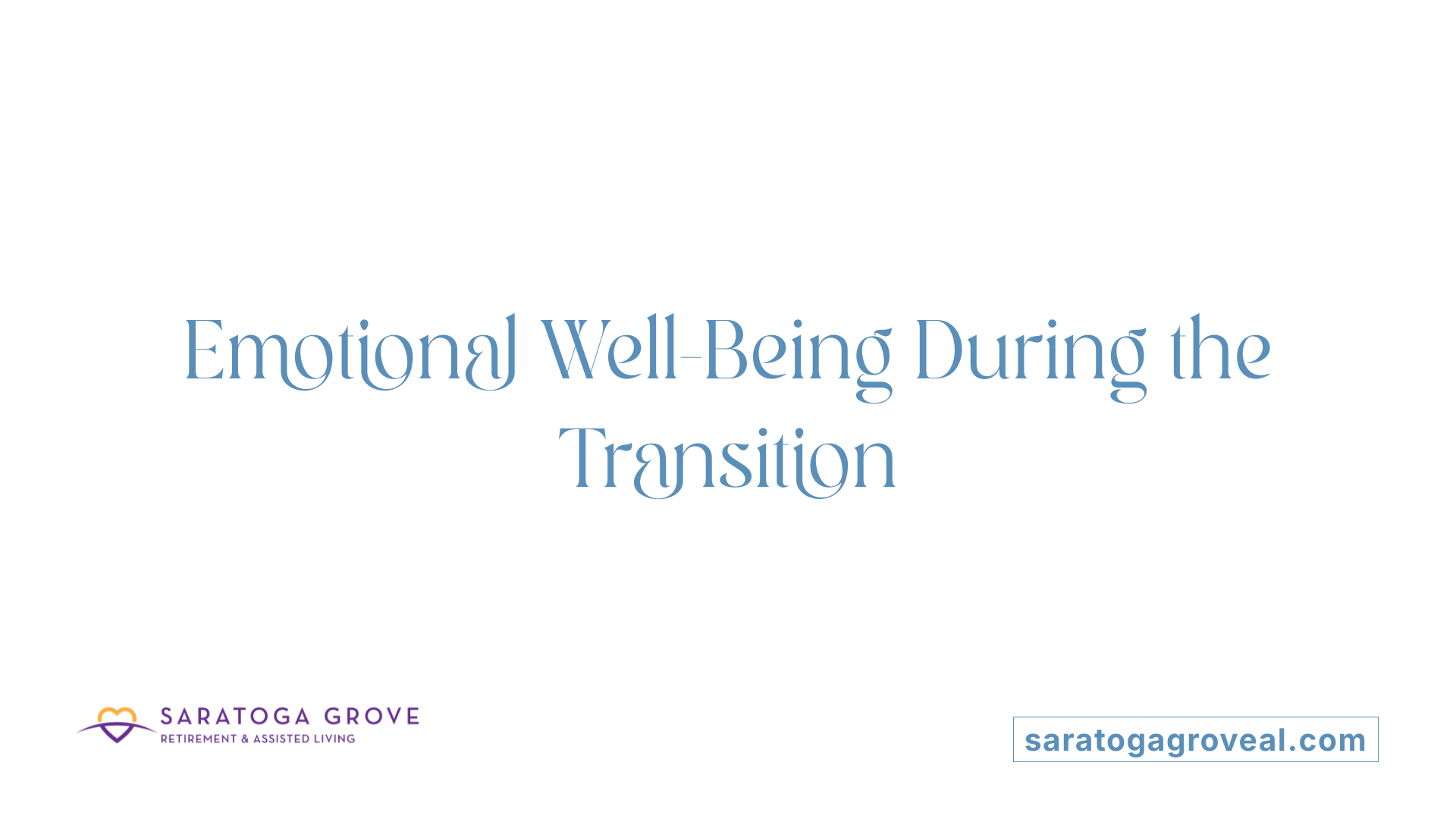
What to Expect When Moving into an Assisted Living Facility
March 27, 2025
Navigating the Transition to Assisted Living: A Comprehensive Guide
Understanding the Journey Ahead
Moving into an assisted living facility is a significant life change that demands both emotional readiness and practical preparation. Whether you or your loved one is just beginning to consider this step or are further along in the decision-making process, it's crucial to understand what the journey entails. From discerning when it's time to make the move, to managing the logistical and emotional aspects of the transition, this guide will walk you through the essential considerations to ensure a smooth and positive experience.
Recognizing the Right Time for Assisted Living

What are the signs that it might be time for assisted living?
Deciding when to transition an older loved one into assisted living can be a challenging process. However, certain signs can indicate that such a move may be necessary. Here are a few key indicators to watch for:
- Decline in Personal Hygiene: Difficulty maintaining cleanliness or neglecting personal care can be a sign of struggling with daily tasks.
- Challenges with Daily Living Skills: If an older adult is having trouble with activities like cooking, cleaning, or managing medications, it could indicate a need for extra help.
- Cognitive Decline: Signs of confusion, forgetfulness, or difficulty processing information can be alarming and are often a significant indicator.
- Social Isolation: Withdrawal from social activities or friends can lead to loneliness, further impacting their emotional well-being.
- Persistent Pain or Poor Mobility: Experiencing ongoing pain or decreased mobility can make it hard to live independently and may necessitate professional assistance.
- Caregiver Burnout: If family caregivers are feeling overwhelmed or exhausted by their responsibilities, it might be time to consider professional support.
- Safety Concerns: Frequent falls, unexplained bruises, or a cluttered, unsafe living environment are critical red flags that require attention.
Recognizing these signs early on can significantly help maintain a senior's well-being and quality of life, ensuring they receive the care they need.
Preparing for the Move: Key Considerations

How can I prepare for a move to assisted living?
To prepare for a move to assisted living, start by researching various communities to understand their amenities and social environments. Schedule on-site tours to get a feel for each facility’s atmosphere and ask current residents about their experiences.
Next, approach logistics with a clear plan. Handle paperwork early, including selling your current home and updating your mailing address. Don’t forget to cancel utility services and register to vote at your new address. Create a moving timeline to stay organized and reduce stress during the transition.
When it comes to packing, be deliberate. Bring personal items that will make your new space feel like home—think about cozy clothing, keepsakes, and essential health items. However, assess the size and shape of your new living area to decide on larger furniture. Remember to include cleaning supplies, as well as decorations, to personalize your apartment.
Lastly, prepare emotionally. Reflect on cherished memories in your old home and create plans for your new living space. Upon moving, make an effort to meet your neighbors, connect with caregivers, and participate in community events. These steps help build social connections that can ease feelings of loneliness and provide a support system in your new surroundings.
Efficient Packing Strategies for a Seamless Transition
How do I pack for assisted living?
Packing for assisted living requires thoughtful planning and organization. Start by creating a comprehensive checklist tailored to your new living space.
- Obtain a Floor Plan: Knowing the layout of your new apartment helps in choosing furniture that fits well without overcrowding the space.
- Essential Furniture: Consider bringing a familiar bed, a small kitchen table, and a comfortable chair to help create a cozy environment.
- Daily Necessities: Pack items like toiletries, a mini-fridge, and daily medications to ensure quick access.
- Comfortable Clothing: Choose clothing that is easy to wear and fits well in closet space.
- Personal Items for Comfort: Include sentimental items like photographs or hobbies that provide emotional support.
- Limit Clutter: Avoid packing unnecessary decorative items and large pieces of furniture, which can create a sense of confinement.
Planning for new space
When preparing for the move, consider the available space and prioritize what you need. A useful strategy is to write down a list of items you use regularly throughout the week. This can help in determining which items are truly essential for your new home.
Use a system to categorize your belongings into keep, trash, or donate, making the downsizing process less overwhelming.
Through careful packing and planning, you can ensure that your transition to assisted living is smooth, comfortable, and personalized to your needs.
Navigating Legal and Guardian Considerations

Legal Authority for Moving
When considering the placement of a loved one into assisted living, legal authority plays a crucial role. Each situation involves the rights and preferences of the individual being moved, which is why it is essential to understand the legal mechanisms in place for such transitions. If there's concern for a loved one's safety and decision-making capabilities, various legal frameworks come into play, including guardianship and power of attorney.
Guardianship vs. Power of Attorney
Guardianship allows a person to act on behalf of another, usually through a court-determined process. This is particularly relevant when the individual cannot make sound decisions about their care. A judge typically requires clear evidence, such as medical assessments, to establish that the person cannot live independently. On the other hand, a Power of Attorney (POA) grants someone authority to make decisions but does not allow for forced placement in assisted living. Thus, if a loved one resists moving, obtaining guardianship may be necessary to proceed legally.
Can a Loved One Be Moved to Assisted Living Against Their Will?
Moving a loved one to assisted living against their will is not straightforward. Generally, a court-ordered guardianship is essential, compelling the individual to demonstrate incapacity convincingly. Judges prioritize the rights and autonomy of older adults, making it vital to provide substantial evidence of the individual’s inability to live independently. Given the complexities of this legal transition, consulting with an elder care attorney can help navigate the required steps and understand available options for family members facing this challenging decision.
Understanding Disqualifications in Assisted Living

What disqualifies someone from assisted living?
A senior may be disqualified from assisted living if they pose a risk to the safety and well-being of other residents. This can include:
- Severe cognitive impairments: Conditions such as advanced dementia can hinder an individual's ability to understand their surroundings or follow essential safety protocols.
- Extensive medical care needs: Seniors requiring constant nursing assistance or advanced medical interventions may not fit the level of care typically provided in assisted living environments.
- Being bedridden: Seniors who cannot participate in daily activities and depend on high levels of support may not be suitable for admission.
Ultimately, the focus is on maintaining a safe, supportive community for all residents, ensuring that those admitted can thrive in their new environment while receiving necessary assistance.
Health conditions affecting eligibility
Eligibility for assisted living communities is strictly monitored to keep residents safe. Common health conditions that can disqualify individuals include:
| Condition | Explanation |
|---|---|
| Advanced dementia | May prevent the person from ensuring their safety. |
| Serious mental health disorders | Can disrupt community harmony and individual well-being. |
| Severe mobility impairments | Limits participation in communal activities and self-care. |
In short, suitability for assisted living depends on balancing individual needs with community standards and regulations, ensuring everyone has a secure and supportive living experience.
Emotional Adjustments and Support Systems

What are the emotional adjustments needed for transitioning to assisted living?
Transitioning to assisted living involves significant emotional adjustments for both the individual and their family. As families prepare for this change, it's important to communicate openly about feelings and concerns.
Common emotions during this transition can include:
- Relief: Many families feel a sense of relief knowing their loved ones will be safer and have access to care.
- Guilt: Some may struggle with guilt, believing they are relinquishing their loved one's independence.
- Sadness: Leaving a long-time home can evoke feelings of sadness and loss.
It's essential to recognize these emotions and validate them as part of the process. Emotional preparation, such as discussing the change and participating in community events together, can ease anxiety.
How can family and community involvement aid the transition?
Family and community support play critical roles during this transition. Here are some ways to foster involvement:
- Regular Visits: Staying connected and visiting frequently helps maintain emotional ties.
- Participating in Activities: Encouraging loved ones to join in community activities can significantly improve social interactions and overall well-being.
- Meeting New Friends: Engaging with new neighbors and participating in communal events fosters a sense of belonging.
Involvement from family members not only enhances the senior's experience but also allows caregivers to enjoy their relationships without the burden of caregiving. By providing emotional support and reassurance, family can make the transition to assisted living smoother and more positive for everyone involved.
Evaluating the Advantages and Disadvantages
What are the pros and cons of assisted living?
Assisted living facilities offer a variety of support services tailored for individuals needing assistance with daily activities. Some of the notable advantages include:
- Support with Daily Activities: Residents receive help with bathing, dressing, and medication management, which can enhance their overall quality of life.
- Social Opportunities: These facilities often organize group activities and events, helping residents socialize and reducing feelings of loneliness.
- Safety Measures: Designed to minimize risks, assisted living environments prioritize safety, providing immediate assistance in case of emergencies.
Despite these benefits, there are potential drawbacks to consider:
- Financial Costs: The expenses associated with assisted living can be significant, posing a financial burden for many families.
- Privacy and Autonomy: Residents may feel a loss of privacy and independence as the community setting imposes certain limitations on personal space and choices.
- Medical Care Limitations: While assistance with daily living is a core service, the availability of specialized medical care may vary, which could be a concern for those with complex health needs.
Overall, assessing the pros and cons is crucial for helping families make informed decisions about assisted living.
Exploring Long-Term Care Options Beyond Assisted Living
What long-term care options are available beyond assisted living?
Beyond assisted living, a variety of long-term care options are available to cater to different needs and preferences.
Nursing Homes
These facilities provide extensive medical and personal care, making them suitable for individuals who require around-the-clock supervision. They are often staffed with trained nursing professionals equipped to handle complex health issues.Continuing Care Retirement Communities (CCRCs)
CCRCs offer a continuum of care, allowing residents to seamlessly transition between independent living, assisted living, and nursing care as their needs evolve. This model promotes stability and comfort as seniors age.Residential Care Homes
Smaller than traditional nursing facilities, these homes offer a more intimate living environment with personalized attention and care. They cater to seniors looking for a homelike atmosphere while receiving assistance with daily tasks.Adult Day Care Centers
These programs provide structured activities and support for seniors during the day while allowing them to return to their homes in the evening. They can be a great option for families needing temporary relief from caregiving duties.Home Care Services
For seniors who prefer to remain in their own homes, home care services offer assistance with daily activities such as personal care, meal preparation, and companionship, enabling them to maintain their independence.
Different circumstances and preferences in care length necessitate understanding these options to choose the best fit.
Making the Most of Life in Assisted Living
Personalizing the Space
Settling into a new home in an assisted living facility is greatly enhanced by personalizing one's living space. Bringing items that hold sentimental value, such as photographs, heirlooms, and favorite decorations, can create a more familiar atmosphere. Organizing the apartment according to preferences not only maximizes comfort but also encourages a sense of ownership.
To make the most of limited space, consider multi-functional furniture, such as a small table that serves as both a dining area and activity space. This approach maximizes functionality while keeping the environment cozy.
Engaging with Community Activities
Engagement with others is vital for emotional well-being. Assisted living communities usually offer a variety of social activities—from arts and crafts to exercise classes—that foster connections with fellow residents.
Participating in these activities can ease the transition and help build new friendships, providing important social support. Residents are encouraged to explore local happenings, which often create opportunities for shared experiences and deeper bonds within the community. Maintaining regular contact with family and friends also fosters emotional stability, further enhancing life in assisted living.
Taking these steps helps seniors feel more at home and connected, making their new environment vibrant and welcoming.
Final Thoughts
Successfully moving into an assisted living facility involves careful planning, emotional strength, and a deep commitment to making informed choices. By understanding when assisted living is needed, preparing for the move with both practical and personal considerations, and being open to the support from family and community, the transition can lead to a rewarding and enriched lifestyle. Remember to explore all care options available and stay engaged with the new community to make the most of this new chapter.
References
- Moving to Assisted Living Checklist | A Place For Mom
- What To Bring To Assisted Living - The Complete Checklist
- The Ultimate Checklist for Moving to Assisted Living
- Assisted Living Packing Checklist - Aegis Living
- [PDF] Moving Into An Assisted Living Residence: Making A Successful ...
- Moving to Assisted Living Checklist: 9 Steps to Help You Prepare
- Long-Term Care Facilities: Assisted Living, Nursing Homes, and ...
- What to Expect on Moving Day | Brookdale Senior Living
- What to Expect After Moving a Loved One Into Senior Living



































































































